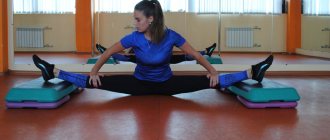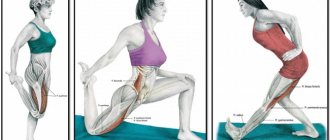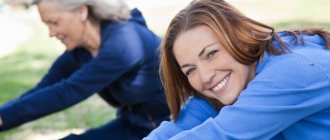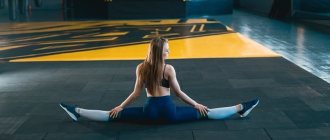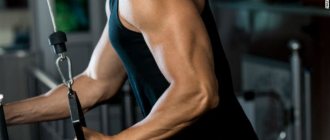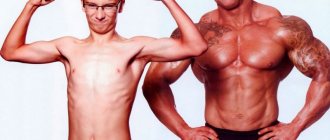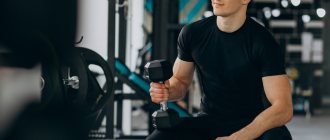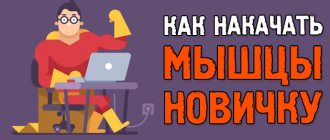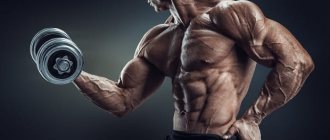Gaining muscle mass is not only a goal for young people; bodybuilding after 40 years for men is not only possible, but even necessary. Often, this is the goal of older men and women. There are many reasons for this desire.
Sometimes, when you are over 50, you suddenly hear about the benefits of a healthy life and decide to correct the mistakes of your youth.
Others simply want to have a great figure at this age, but is it possible to build muscle at 40 and perform physical exercises after 50? All this is possible.
Gaining muscle volume at this age is more difficult than before, for the reason that the body is not able to quickly recover after exercise. But this doesn't mean you can't start building muscle after age fifty.
In fact, it is not at all difficult and bodybuilding after 40 years is possible, but there are some things you should first learn about.
Luckily, this article covers it all and we hope it will help you achieve a ripped figure at this wonderful age.
Muscle mass after 50 years
Before we dive into the topic of exercise, we must first understand how muscle mass begins to decrease after fifty and how to gain weight in old age.
As you get older, you may notice a gradual decrease in muscle mass. Over time, muscles lose both volume and elasticity.
There are two main reasons for the loss of muscle mass with age.
The first is that the body cannot restore muscles at the same speed as before. Therefore, wounds heal more slowly than at twenty years old. The second reason is that you don’t spend much time in the gym, you have other things to do that simply don’t leave time for training.
These two reasons are related to each other: the body recovers more slowly precisely because you do not exercise.
You have a job, children and grandchildren, not to mention the fact that besides this you have many other things to do and you have no time to go to the gym and work out.
Since you are not doing any sports or other physical activity, your heart rate begins to slow down. When the heart rate slows, blood moves more slowly, making it more difficult for nutrients and oxygen to reach the body's cells.
And if you return to an active lifestyle, you will literally turn back the passage of time, become stronger and notice that your body heals wounds faster.
Besides all this, you will feel much better and younger.
Find and tighten the weakest links
Physical fitness is determined by many adaptation mechanisms and abilities of the body. They all tend to decline with age and/or inactivity, but they deteriorate at different rates. For example, it is relatively easy to stay strong into adulthood, but the same may not always be true for mobility, endurance, or peak power.
Here's a simple question to help you focus on this topic: what could you easily do at 18 that you can't easily do today? Run? Jump? Throw or catch the ball? Get up off the floor? Touch your toes? See your toes?
Whichever answer you choose, it indicates physical abilities that have noticeably deteriorated over the years.
The various physical indicators that make up the overall picture of physical fitness are like a woven web. The development of one quality affects the development potential of all others. Physical abilities are like strands of a spider's web; you can't touch one strand without disturbing all the other strands.
Diet and muscle growth in adulthood
To build muscle, you still need to consume enough protein. Muscle is made up almost entirely of protein, so you need to get more protein from your diet. There's nothing new here.
But as you age, the composition of your diet becomes even more important, because it affects not only muscle growth, but also the overall health of the body. Muscle growth without protein consumption is impossible, both after 50 years and at any other age.
If you previously relied on red meat for muscle growth, now, at this age, your diet needs to change.
You should eat foods that are low in fat.
Most likely, your heart muscle does not have the same strength as before, and therefore the veins and arteries may have narrowed due to time and fat deposits.
If your heart rate speeds up, it will have a good effect on the body as a whole, but if you also consume fat along with protein, it will harm your cardiovascular system.
If you want to both build muscle and stay healthy, you should eat low-calorie, high-protein foods instead of fatty meats.
According to CNN, you should eat even more protein than before because muscle starts to break down as you age, and you need to provide it with protein to prevent this.
Protein sources that are appropriate for your age include chicken, turkey, dairy and other low-calorie foods.
Protein shakes and supplements are also a great option. But when choosing a supplement, you should pay attention to its cholesterol and salt content.
It is recommended to consume protein regularly and in portions so that the body can absorb it correctly and completely.
If you take 60 grams of protein at once, the body simply will not be able to absorb all this protein, and you will lose some of it.
To prevent this from happening, you should divide the required daily amount of protein between several meals. This will provide the muscles with a sufficient amount of protein and maintain normal metabolism.
Also try other supplements, such as creatine, it will help retain more water in the muscles and increase their strength. The site describes how to take creatine monohydrate for muscle growth.
HOW TO GROW UP BEAUTIFULLY - THREE AMAZING STORIES
Evgenia Stepanova
When Evgenia turned 60, she seriously decided to take up sports professionally, or rather diving from a tower. In general, Evgenia dreamed of jumping into the water from a tower for a very long time, but in her youth, being an engineer, she could not make her dream come true. And only at an age did she find the time and energy to start a career as an athlete.
A friend agreed to become a coach and Evgenia began training three times a week. Over the course of a year, the athlete got into shape and developed the jumps necessary for the competition. Despite her husband’s protest, Evgenia competes at the championships. Now she is 74 and in excellent shape, she has moved to another age group, in which she is considered the strongest athlete. International medals are the pride of this now famous athlete.
Charles Eugster
“Grow old without getting sick” is the motto of this 93-year-old athlete. Despite his advanced age, he does not take pills, and only takes vitamins and protein for muscle growth.
Charles began his health journey at age 60. Until this age, the future athlete did not engage in sports, but rather liked to lie on the sofa. From this lifestyle, Charles developed low blood pressure, varicose veins and other ailments. But one day he heard that rowing competitions were being held for people his age, he remembered his youth and decided to take part. For this, Charles changed his diet, lifestyle and began to train hard.
After two years of training, the man realized that his previous illnesses no longer bothered him and this interested the athlete. Charles decided to continue his health experiment.
By the age of 85, Charles began to have a “midlife crisis.”
At the age of 87, Charles became a bodybuilder, lost excess fat and toned his body.
DESPITE HIS AGE, BODYBUILDING AND regattas, CHARLES DOESN'T QUIT WORK
Charles worked as a dentist until he was 75, as a publisher of a dental newsletter until he was 82, as a fitness center promoter until he was 92, and is now 93 and looking for a new job.
Now the athlete is looking not only for a new job, but also for a girlfriend, however, Charles emphasizes that for now only girlfriends, and nothing more, since he is not yet ready for marriage.
Charles is now 93, but he is full of strength, the desire to continue his sports activities and the desire to work.
Ernestine Shepard
At 74, the Baltimore native entered the Guinness Book of Records as the oldest female bodybuilder. Ernestina began bodybuilding at the age of 56. Now she is 81, she is at the peak of her form, an active trainer, a professional model and just a beautiful woman.
But it was not always so. Until the age of 56, Ernestina led a sedentary lifestyle (worked as a secretary) and never bothered herself with physical activity. Everything turned upside down at the age of 56, when she and her sister were trying on a swimsuit in a Baltimore store. They laughed at each other for a long time because of their poor body shape, and then they mutually decided to join a fitness club.
The woman began to do strength training 4 times a week, and at the age of 71 she competes in her first competition, the Natural East Coast Tournament of Champions, and takes 1st place in her category, ahead of women who are decades younger than her.
In 2011, the athlete received the title of oldest competitive female bodybuilder and entered the pages of Guinness World Records.
The athlete’s height is 165 centimeters, weight is 59 kilograms, body fat percentage is 9-10%
She wakes up at 4 o'clock in the morning to run, and in a week she runs 130 km. For those who cannot run, Ernestina advises starting with evening walks.
The motto of this purposeful athlete is:
IF YOU'RE OVER 50, IT'S TIME TO START TAKEN CARE OF YOURSELF
Of course, there are many such stories, but all of them are proof that after fifty years: life can be brighter, the body more beautiful, and health greater than in younger years. Muscles readily respond to physical activity at any age, the brain gains strength over the years, which means that after 50 you can live a full and happy life. The main thing is to start taking care of your health, persistently pursue your goal, and all the best will follow.
Be healthy, Oleg
Power training
To increase muscle mass over the age of fifty, focus on strength training.
Strength exercises are the only way to build muscle after 40, and also improve their quality and strength.
However, the strength training you need to do at this age is a little different than what young adults need in their 30s.
The exercises themselves will be the same, but you should group them differently: today you pump up your biceps, tomorrow your chest, and your legs the next day.
This will allow the muscles you worked to recover from exercise, since they have a whole week to rest.
In adulthood, muscles should be given sufficient time to recover after exercise. Since now the muscles, like the rest of the body, recover more slowly, you should avoid intense exercise.
Ten to fifteen repetitions should be performed per set, and there should be three sets per day.
As you can see, the number of repetitions has increased compared to what you were doing before.
All fitness guides recommend doing eight or twelve repetitions. However, at your age, start by lifting lighter weights more times.
And when your joints and ligaments become stronger thanks to training, then you can start working with heavier weights.
The most important thing is to make sure that your bones, ligaments and joints are strong and healthy enough to handle these exercises. The worst that could happen right now is an injury due to intense exercise, which could keep you out of physical activity for months.
How to train older athletes?
The training process both after and before the age of forty has practically no significant differences regarding the choice of strength exercises and training methods. This does not mean that you can do absolutely everything that athletes can afford due to their younger age, for example, at 20 or 25 years old.
There are some nuances that will have to be taken into account:
Be careful when handling heavy weights
Lifting heavy to moderate weights is considered the best way to develop strength and increase muscle mass. But there is also a downside. Weights place significant stress on joints and damage muscle fibers.
This doesn't mean you should stop lifting heavy weights. The main thing is to correctly calculate your own physical fitness and fitness. Untrained older people are advised to start lifting weights with low repetitions. When eight or ten sets become easy, you can increase the range.
The number of approaches and repetitions should be dictated solely by your own feelings. You shouldn't overpower yourself. Increasing the load is welcome, but not required. Of course, it is impossible to strive for higher results when there are no physical prerequisites for this and sufficient strength.
Paying attention to pain in the joints, lower back, etc.
People experiencing low back pain should not perform deadlifts. The exception is when the therapist has prescribed this particular exercise. The presence of pain in the knee joints requires abstinence from squats, and in the shoulders - from bench presses while lying or standing.
You should not, overcoming pain, continue exercising with a load on the source of pain. Otherwise, the situation will worsen and you will have to forget about visiting the gym for months. It's better to focus on other exercises and then work on problem areas when the pain goes away.
Recovery and rest come first
If you spend the whole week in the gym, this is fraught with overtraining. To avoid exhaustion, you should not neglect the recovery process after each strength training session. And if we talk about how age affects this period, then the changes are not as significant as many people think.
The time required for the muscles and body to recover after exercise may require a little more. The main thing is to make sure you get enough sleep, at least 7 hours, and consume the recommended amount of protein. In addition, every 6 weeks or 2 months you need to take a break from classes for 7 days.
Find a personal trainer
If you haven't exercised for a while but are looking to get back into shape, a personal trainer can help.
He will not only motivate and encourage you during the exercises, but will create a training program and explain how to perform the exercises correctly.
The older you are, the higher the likelihood of some kind of injury during exercise. And if you haven't exercised for a while, you can very easily hurt yourself while exercising.
And a coach will help you avoid this.
He will explain and show you how to perform the exercises correctly, show you how to properly pump up the muscle and what mistakes to avoid.
Exercise machines can also help you, which you need to use at least in the first two classes.
The machine allows your muscles to get used to working again, so when you take on the free weights, they will already be in a prepared state.
The machine also has stability, the lack of which when working with free weights leads to injuries.
As Cassie White says in an article for Australian Health & Wellbeing, the key is to get your muscles back into exercise mode.
But if you haven’t trained for a long time, then you won’t be able to get back to where you once left off the first time.
The body gets used to what it does most often, therefore, if you have not exercised for several years, then the body is already unaccustomed to work, and trying to do more than you are currently capable of will inevitably lead to injury.
Gaining muscle mass takes time, but everything is achievable.
Where to begin
When asking yourself whether it is possible to build muscle at 50 years old, you should understand that the answer is yes, but only if you are ready for active and conscientious work. In order to pump up without harm to health, it is recommended to follow a certain algorithm, namely: • First, visit a doctor (therapist) to determine the permissible intensity of the upcoming loads or simply find out whether it is possible to start actively playing sports in this state, • Choosing a set of exercises and type of sport (it’s better to start with a professional trainer), • Introduce morning exercises into your daily schedule, aimed at stretching and training the ligaments.
How can a 45 or 50 year old man get pumped up without harming his health?
In this section, we'll look at the barbell exercises you should do, as well as alternatives if your joints can't handle some of the exercises.
If you haven't lifted a barbell for a long time, start with other strength exercises for at least two days. In between these two days, leave one day without exercise to allow your muscles to rest and recover.
Take the exercises slowly and don't sacrifice proper form to lift more weight.
Many people, even before they reach fifty years of age, begin to have problems with the joints of their shoulders and knees, and therefore you may not perform some of the exercises on this list.
Bench press
The bench press is a very important exercise that benefits the entire upper body.
When you're just starting out, it's a good idea to use a dedicated bench machine so you can focus on technique rather than stabilizing the bar.
You can also work with a heavy barbell in a machine, and then perform several repetitions with a light barbell, but without a machine.
The bench press does not increase muscle size, but trains the entire body and stabilizes its response to stress.
This way, when you move on to working with free weights, your body will already have experience and it will be easier for you to get started.
Dumbbell press
The dumbbell shoulder press is another essential upper body exercise.
It improves overall body functioning and can even reverse the age-related changes your body has experienced and muscle loss.
This exercise is a great option because it works all three deltoid muscles.
Upper block pull
This exercise is good for your back muscles.
Vertical block rows are performed on a special simulator. The exercise also targets the arm muscles.
The good thing about the simulator is that exercises on it can be done completely safely for muscles and ligaments.
Hands should be kept as vertical as possible during the exercise.
Dumbbell Curls
Bicep curls build your biceps and strengthen your triceps.
But if you have pain in your elbow joints, then exercise with free weights should be avoided. Use a trainer instead.
The simulator allows you to fix your hand on a stand, which will ensure correct technique and reduce the load on the joints.
Also, the machine will not allow the back muscles to do part of the work, which will also prevent back pain. Also pump up your triceps.
The triceps exercise works the same way as the biceps exercise, only in reverse. An arm rest minimizes stress on the elbow and prevents sprains.
Squats
It will be more difficult to pump up your legs because many people over fifty already have pain in their knees or hip joints.
If you are lucky enough to have no joint problems, you can do traditional squats. To stabilize the movement during squats, use a Smith machine.
The Smith machine simply secures the barbell with the weight so that it does not move to the sides when you perform squats.
But if your legs hurt, then you shouldn't use weights at all. Try squats without a barbell.
Leg press
The leg press machine takes the stress off your knees and hips.
Instead, you sit with your back at a 45-degree angle. You push a flat surface with your feet. This exercise is good for the quadriceps and gluteal muscles.
If you want to specifically pump up any specific muscle groups, talk to a trainer.
He will select special exercises for you that will help you achieve the results you need.
Cardio loads
Decline in VO2max with aging in master athletes and sedentary men., A comparison of longitudinal changes in aerobic fitness in older endurance athletes and sedentary men. general endurance, so that you become short of breath even from the simplest movements, and your heart and lungs no longer work so well. Regular cardio loads slow down this decline by two or more times, increase endurance, protect against heart and vascular diseases, and even reduce Postponed development of disability in elderly runners: a 13-year longitudinal study. risk of death.
The word "cardio" often refers to running, but it is not the only option for developing overall endurance. Bogachev advises choosing exercises without impact on the joints: Nordic walking, skiing, rowing, ergometer pedaling, swimming.
Evgeniy Bogachev
To maintain a high quality of life, two workouts per week are enough.
How intense should you exercise?
There are two options: monitor your heart rate or train by feeling. If you choose the first, make sure that your heart rate does not rise above 160 beats per minute during training. You can see the exact values of the aerobic zone here.
Keep in mind that many fitness bracelets incorrectly display your heart rate, overestimating it by 10–20 beats per minute. Devices with chest sensors display your heart rate as accurately as possible. But it’s much easier to navigate by sensations.
Evgeniy Bogachev
If you can carry on a conversation while moving, the intensity is chosen correctly.
As your training increases, you will be able to exercise more intensely without harm. Impact of age, performance and athletic event on injury rates in master athletics - first results from an ongoing prospective study. for health, but you should start gradually. Follow your feelings and take your time.
Choose cardio workouts

